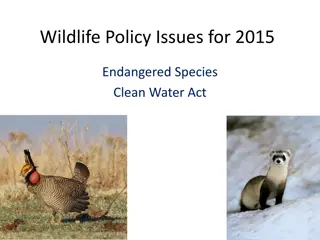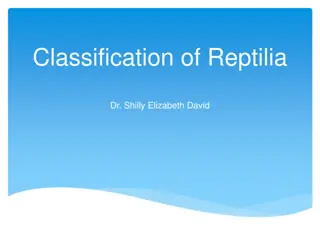Explore the Fascinating World of Wild Animals and Their Habitats!
Journey through a visual encyclopedia showcasing a variety of wild animals such as bears, cheetahs, elephants, and more, along with information on different animal types like mammals, reptiles, and birds. Discover the diverse habitats where these creatures reside, from jungles and forests to deserts
0 views • 35 slides
Understanding Animal Classification: Mammals, Birds, Reptiles, Fish, and Amphibians
Explore the world of animal classification through 5 distinct groups - mammals, birds, reptiles, fish, and amphibians. Discover what sets each group apart, from their bone structure to unique characteristics like fur, beaks, scales, and more. Engage in activities to identify and understand the featu
10 views • 4 slides
Comparing Groups of Vertebrates: Features and Differences
Explore the key characteristics of five groups of vertebrates - mammals, birds, reptiles, amphibians, and fish - including details on blood type, offspring, skin, and breathing apparatus. Learn about the unique traits that distinguish these vertebrate groups from one another.
0 views • 4 slides
Fascinating Facts About Iguanas: From Skills to Survival
Iguanas, part of the Iguanidae family, are unique reptiles with special skills like tree climbing and predator evasion. They face threats due to human consumption and environmental hazards, such as oil spills for marine iguanas. Their sensory organ, Jacobson's organ, helps them navigate their surrou
0 views • 10 slides
Overview of Laboratory Animals and Their Uses in Biomedical Research
Laboratory animals play a crucial role in biomedical research, serving as models for studying various conditions affecting humans and animals. They must thrive in controlled conditions and are used to test hypotheses and drugs. Commonly used lab animals include rodents, lagomorphs, canines, felines,
0 views • 9 slides
Understanding Aquatic Adaptation in Animals
Aquatic adaptation refers to the changes in an animal's body organization to thrive in a water habitat. Vertebrates have evolved to lead partial or total aquatic lives, showcasing various adaptations. Water as a habitat offers a homogenous medium, stable conditions, and rich food resources. Aquatic
0 views • 9 slides
A Comparative Analysis of Ectothermy vs. Endothermy in Organisms
Ectotherms regulate body temperature externally, relying on environmental heat sources, while endotherms produce heat internally. Ectotherms like reptiles and fish have advantages such as lower metabolic rates and food requirements, while endotherms like birds and mammals have higher energy needs du
0 views • 16 slides
Jaw Suspension in Vertebrates: Types and Mechanisms Explored
Jaw suspension in vertebrates involves the attachment of the lower jaw to the upper jaw or skull for efficient biting and chewing. Different types of jaw suspensions exist, such as holostylic and autosystylic, each based on modifications in visceral arches. Holostylic suspension involves the lower j
0 views • 10 slides
Discover Fascinating Gecko Facts and Unique Reptiles of New Zealand
Explore interesting facts about geckos, including their diverse sizes, behaviors, diet, and unique features like tail regeneration and ability to walk on smooth surfaces. Learn about the enchanting world of New Zealand reptiles and the efforts of conservation. Delve into the nocturnal world of gecko
3 views • 7 slides
Vertebrates Final Review - Study Guide with Images
Explore the world of vertebrates with this comprehensive final review. Learn about chordates, fish, amphibians, reptiles, birds, and mammals through informative images and questions. Test your knowledge on topics like excretion, respiratory organs, locomotion, and anatomical features unique to chord
0 views • 74 slides
Wildlife Policy Issues for 2015: Endangered Species & Clean Water Act
Overview of policy issues surrounding endangered species and clean water act in 2015, including definitions, history, causes of endangerment, petition and listing factors. Focus on protecting species like the Lesser Prairie Chicken and Black-footed Ferret. Mention of Kansas' threatened and endangere
0 views • 21 slides
Exploring the Fascinating World of Dinosaurs
Delve into the world of dinosaurs - ancient reptiles that roamed the Earth millions of years ago. Discover the various types of dinosaurs, their unique characteristics, reproduction methods, diet preferences, and the mystery surrounding their extinction. Uncover the remnants of these creatures throu
0 views • 10 slides
Snake Safety Awareness and Pennsylvania Snake Species Overview
Discover essential snake safety tips and interesting facts about snakes, including the diverse snake species found in Pennsylvania. Learn about venomous and nonvenomous snakes, distinguishing features, and how to stay safe around these fascinating reptiles.
0 views • 26 slides
Understanding the Classification and Features of Reptiles
Reptiles belong to the Class Reptilia and are known for their cold-blooded nature, dry skin with epidermal scales, and unique skeletal features. They are classified into different subclasses and orders based on their characteristics. The distinct skull structures of anapsids and synapsids define the
0 views • 28 slides
Understanding Purine Degradation and Gout
Purine degradation pathway involves the breakdown of dietary nucleic acids, mainly from meat, into uric acid through specific enzymatic steps. Excessive uric acid production can lead to conditions like gout and hyperuricemia. Humans excrete uric acid in the urine as the final product, while other an
1 views • 12 slides
Hierarchical Semi-Supervised Classification with Incomplete Class Hierarchies
This research explores the challenges and solutions in semi-supervised entity classification within incomplete class hierarchies. It addresses issues related to food, animals, vegetables, mammals, reptiles, and fruits, presenting an optimized divide-and-conquer strategy. The goal is to achieve semi-
0 views • 18 slides
Year Two Curriculum Plan: Summer Term Two Overview
This curriculum plan for Year Two covers various subjects like Religious Education, English, Maths, Science, History, PE, and Music for the Summer Term Two. The plan includes topics on The First Christians, reptiles, time in Maths, Little Master Chefs in Science, and Local Heroes in History. Childre
0 views • 4 slides
Discover the Beauty of Cikowicko-Ronowski Landscape Park
Cikowicko-Ronowski Landscape Park, established in 1995, is a stunning natural reserve in the Małopolska province. Spanning 24,130 hectares, the park showcases diverse geological formations, rare flora, and a variety of wildlife. The park is home to unique rock outcrops, sandstones, and a Petrified
0 views • 15 slides
Exploring Vertebrates: Reptiles, Birds, and Mammals
Delve into the world of vertebrates, including reptiles, birds, and mammals. Discover the unique characteristics and adaptations of each group, from the scales of reptiles to the feathers of birds and the live birth of mammals. Explore how these creatures have evolved to thrive in their environments
0 views • 6 slides
Explore the Fascinating World of Insects and Animal Classification
Discover the unique characteristics of insects such as their body parts, legs, compound eyes, antenna, and exoskeleton. Learn about the classification of animals into insects and non-insects, as well as vertebrates and invertebrates. Explore how animals can be sorted based on different criteria and
0 views • 35 slides
Exploring Herpetology: Reptiles, Amphibians, and Their Fascinating World
Delve into the captivating realm of herpetology, the study of reptiles and amphibians. Discover the characteristics of these cold-blooded vertebrates, from scaly reptiles to slimy amphibians. Uncover the similarities and differences between these two groups, their reliance on water, and the rich div
0 views • 22 slides
Animal Classification WebQuest: Dive into the World of Vertebrates!
Discover the fascinating world of animal classification with the Animal Classification WebQuest presented by Joseph Jackson. Learn about the five categories of vertebrates - mammals, reptiles, birds, fish, and amphibians. Dive into tasks like identifying animals, completing worksheets, playing games
0 views • 12 slides
Dragons in Mythology: A Global Phenomenon Throughout History
The widespread presence of dragon legends in various cultures suggests a fascinating connection between dinosaurs and mythical creatures. Across continents and centuries, these tales depict creatures resembling dinosaurs, with scaly bodies, long necks, and fearsome features. The coexistence of human
0 views • 23 slides






















